Chinese Corporation Developing C919 Commercial Aircraft
The COMAC C919, a single-aisle, narrow-body commercial passenger jet produced by the Commercial Aircraft Corporation of China (COMAC), is making waves in the global aviation industry. This advanced aircraft, designed to meet the demand for air travel in China and other emerging markets, has been in commercial operation primarily in China and parts of Southeast Asia since its first delivery in 2021.
With a seating capacity of 158 to 168 passengers and a range of up to 4,075 kilometres, the C919 is broadly comparable to the Airbus A320, albeit slightly slower and carrying fewer passengers. The aircraft's technological advancements, such as its advanced avionics and lightweight composite materials, aim to provide pilots with better situational awareness and improved safety, making it a highly competitive offering in the single-aisle market.
One of the key features of the C919 is its advanced avionics, which includes a glass cockpit and an advanced flight control system. These technologies enhance the aircraft's efficiency and provide pilots with better situational awareness and improved safety. The C919's cabin also boasts wider seats, larger overhead bins, and larger windows for improved passenger comfort.
Since its launch, COMAC has delivered around 165 units of its C-series jets (including the C919) primarily serving Chinese and Southeast Asian airlines. The C919 itself is gaining moderate commercial traction mainly within China and Southeast Asia but with limited reach beyond. Airlines like Lao Airlines, VietJet, and others are operating or scheduled to operate regional jets from COMAC’s portfolio.
Despite its commercial success, the C919 faces significant certification challenges that limit its global market penetration. Both the European Aviation Safety Agency (EASA) and the U.S. Federal Aviation Administration (FAA) have delayed or declined certification, with Europe’s certification unlikely for another 3 to 6 years as of mid-2025. This regulatory hurdle restricts the C919's ability to operate worldwide, limiting it primarily to markets that accept Chinese certification.
COMAC is not resting on its laurels, however. The company is also progressing on the larger C929 long-range twin-aisle jet expected by 2027, aiming to compete directly with Boeing and Airbus wide-body aircraft. The C929 project continues despite Russia’s withdrawal from the original CR929 joint venture due to geopolitical issues.
The development of the C919 represents a major milestone in China's aerospace industry, marking China's ambitions to become a major player in the global aviation market. As the C919 continues to make its mark, it is clear that China is poised to make a significant impact on the global aviation landscape.
The COMAC C919, being a highly competitive offering in the single-aisle market, showcases technological advancements in both avionics and materials. In the realm of finance, the success of the C919 is significant, with around 165 units delivered, primarily serving Chinese and Southeast Asian airlines.
Meanwhile, the aerospace industry is witnessing China's emergence as a major player, with the C919 representing a crucial milestone in China's journey towards global dominance in aviation, primarily due to its technological innovations in finance and aerospace sectors.








